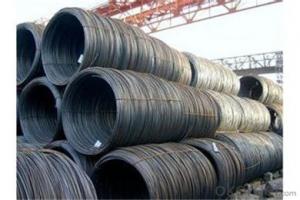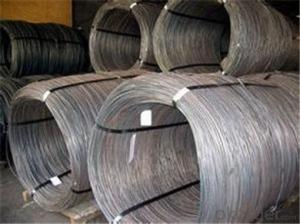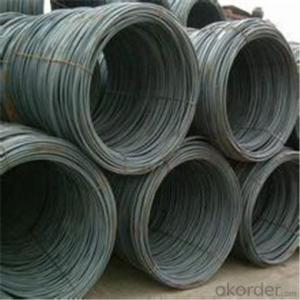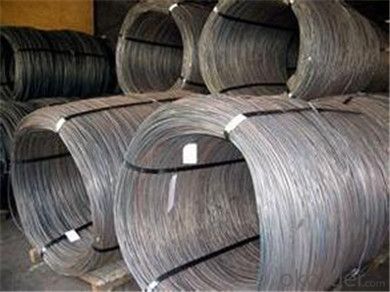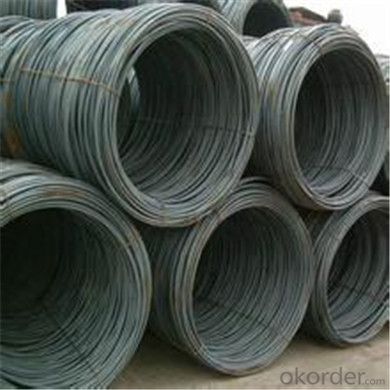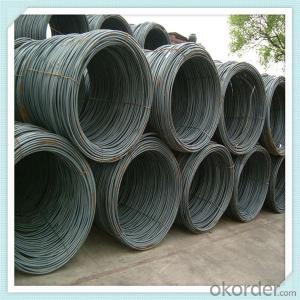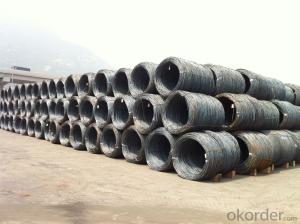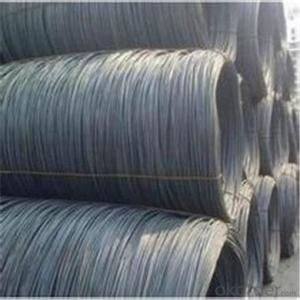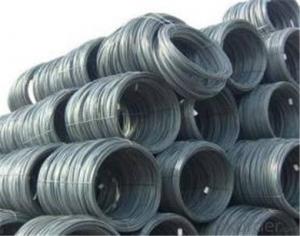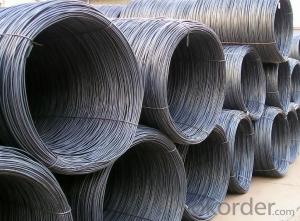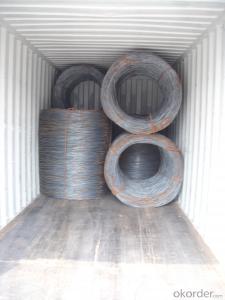SAE1008 Steel Wire rod 5.5mm with Best Quality
- Loading Port:
- Tianjin
- Payment Terms:
- TT OR LC
- Min Order Qty:
- 60 m.t.
- Supply Capability:
- 455566666 m.t./month
OKorder Service Pledge
OKorder Financial Service
You Might Also Like
Specification
Description of wire Rod:
wire rod:
Grade:SAE1006B/SAE1008B/SAE1018B
Size:5.5/6.5/7/8/9/10/11/12mm
Festures of wire Rod:
· fasteners, bolts, rivets, screws,
· general purpose wires,
· electrode wires, industrial wires, agriculture wires,
· bush wires, chain rivet wires,
· detonator wire,
· Umbrella ribs, upholstery wires, cycle spokes, needle wires, heald wires, staple pin Wire, safety pin wires
· ACSR wires, earth wires,
· tyre and hose reinforcement wires,
Specifications of wire Rod:
Grade | Chemical Composition(%) | |||||
C | Mn | Si | S | P | Cr | |
SAE1006B | 0.03~O.07 | ≤0.32 | ≤0.30 | ≤0.045 | ≤0.040 | 0.3-0.35 |
Mechanical properties | ||||||
Yield strength(N/mm2) | Tensile strength(N/mm2) | Elongation(%) | ||||
250-280 | 350-380 | ≥32 | ||||
Grade | Chemical Composition(%) | |||||
C | Mn | Si | S | P | Cr | |
SAE1008B | 0.10max | 0.3~O.50 | 0.15max | 0.050max | 0.040 max | 0.3-0.35 |
Mechanical properties | ||||||
Yield strength(N/mm2) | Tensile strength(N/mm2) | Elongation(%) | ||||
≥195 | 315-430 | ≥30 | ||||
Images of wire Rod:
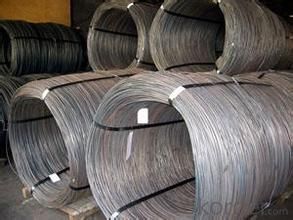
FAQ:
1. What is your package?
Packing situation: standard seaworthy packing or as customer required.
2. How long is the lead time?
Delivery time: 45 days after order confirmed.
3. What payment term do you accept?
Payment: T/T or L/C at sight.
- Q: What are the different packaging options available for steel wire rod?
- Some of the different packaging options available for steel wire rod include coils, reels, bundles, and pallets. Coils are the most common packaging option, where the wire rod is wound into a circular shape. Reels are another option, where the wire rod is wound onto a spool or drum. Bundles involve tying multiple lengths of wire rod together using straps or wires. Lastly, pallets can be used to package wire rod, where the rods are stacked and secured onto a wooden or plastic platform.
- Q: What are the common disposal methods for steel wire rod?
- The common disposal methods for steel wire rod include recycling, repurposing, and landfilling. Recycling involves melting down the wire rod to create new steel products, reducing the need for raw materials. Repurposing involves finding alternative uses for the wire rod, such as crafting or construction. Landfilling is the least preferred method, but sometimes necessary when the wire rod cannot be recycled or repurposed.
- Q: What are the different types of wire brushes made from steel wire rod?
- There exist various wire brushes produced from steel wire rods, each with its own purpose and application. 1. The hand wire brush, the most commonly used type, is suitable for general cleaning and surface preparation. It comprises steel wire bristles attached to a handle, allowing for easy manual use. 2. Cup wire brushes possess a cup-shaped body with steel wire bristles around the edge. They are often employed for removing paint, rust, and corrosion from large surfaces or irregular shapes. 3. Wheel wire brushes, circular in shape, feature steel wire bristles around the outer edge. They are commonly utilized in power tools like angle grinders or bench grinders, making them ideal for heavy-duty tasks such as weld cleaning or deburring. 4. Twisted wire brushes are created by twisting multiple strands of steel wire together. This design provides a more aggressive brushing action, making them suitable for tasks that require abrasive cleaning or surface preparation. 5. Knot wire brushes resemble twisted wire brushes, but each wire strand has individual knots at the end. These brushes are particularly effective in removing heavy rust, scale, or weld spatter from metal surfaces. 6. Strip brushes consist of steel wire bristles attached to a flexible metal or plastic strip. They are commonly employed for sealing or cleaning purposes, such as door seals, conveyor belt cleaning, or surface dusting. 7. Scratch brushes are small handheld wire brushes, often used for cleaning small and hard-to-reach areas. They find common applications in jewelry making, electronics, or precision cleaning tasks. Each of these wire brushes made from steel wire rods possesses distinct features and characteristics suitable for various cleaning, surface preparation, or finishing tasks. The selection of the appropriate wire brush for a specific application is crucial in achieving efficient and effective results.
- Q: How is the surface quality of steel wire rod evaluated?
- The surface quality of steel wire rod is evaluated through various methods and criteria to ensure its suitability for different applications. One common method is visual inspection, where trained inspectors visually examine the surface of the wire rod for any defects or irregularities. This can include checking for surface cracks, pits, spots, or any other visible imperfections. In addition to visual inspection, the surface quality can also be evaluated using non-destructive testing techniques. One such technique is magnetic particle inspection, where a magnetic field is applied to the wire rod, and fine iron particles are applied to the surface. Any surface defects or cracks will disrupt the magnetic field and cause the iron particles to gather, making the defects visible. Ultrasonic testing is another non-destructive method used to evaluate the surface quality of steel wire rod. High-frequency sound waves are transmitted into the wire rod, and any reflections or changes in the sound waves can indicate the presence of defects or irregularities on the surface. Furthermore, the surface quality can be assessed by measuring certain physical properties of the wire rod. For example, the roughness of the surface can be measured using instruments like a profilometer, which provides a numerical value indicating the smoothness or roughness of the surface. This is important as certain applications may require a specific level of surface roughness for optimal performance. Overall, the surface quality of steel wire rod is evaluated through a combination of visual inspection, non-destructive testing techniques, and physical property measurements. By employing these evaluation methods, manufacturers can ensure that the wire rod meets the required standards and is suitable for its intended use.
- Q: How is steel wire rod used in the production of wire shelves and racks?
- Steel wire rod is a critical raw material used in the production of wire shelves and racks. It is first formed into wires of specific diameters, which are then further processed through various shaping and welding techniques to create the desired shelf or rack designs. The steel wire rod provides the necessary strength and durability to withstand the weight of items placed on the shelves or racks, ensuring their structural integrity. Additionally, the wire rod's corrosion resistance properties make the shelves and racks suitable for both indoor and outdoor use.
- Q: What are the different types of steel wire rod surface defect prevention and mitigation measures?
- There are several types of steel wire rod surface defect prevention and mitigation measures including proper cleaning and maintenance of rollers, regular inspection for any signs of damage or wear, implementation of effective lubrication techniques, usage of high-quality raw materials, and adherence to strict quality control protocols throughout the manufacturing process. Additionally, proper storage and handling practices, such as avoiding exposure to moisture and contaminants, can also help prevent and mitigate surface defects in steel wire rods.
- Q: How is steel wire rod used in the manufacturing of wire rope swivels?
- Steel wire rod is used in the manufacturing of wire rope swivels as it serves as the raw material for producing the wire ropes. The wire rod is first drawn to the desired thickness and then twisted and braided together to form the wire rope. The strength and durability of steel wire rod make it an ideal choice for constructing wire rope swivels, ensuring they can withstand heavy loads and resist wear and tear.
- Q: What are the different surface treatments for steel wire rod?
- Some of the different surface treatments for steel wire rod include galvanizing, phosphating, and coating with a polymer or plastic material.
- Q: What are the different types of steel wire rod surface defect classification systems?
- There are several different types of steel wire rod surface defect classification systems, including the ISO 16120-3 classification system, the ASTM A510M classification system, and the JIS G 3505 classification system. These classification systems provide standardized terms and definitions for various types of surface defects found on steel wire rods, helping to identify and categorize any imperfections or abnormalities in the material.
- Q: How are steel wire rods used in the manufacturing of wire baskets for storage and organization?
- Wire baskets for storage and organization rely heavily on steel wire rods. These rods are essential for creating the wire mesh that shapes the basket. To begin with, the steel wire rods undergo a series of processes, including cleaning, straightening, and cutting. These steps ensure the rods are the desired length and free from any impurities. Once prepared, the rods are then passed through a wire-drawing machine. This machine reduces their diameter to the desired size and increases their tensile strength. Afterward, the wire rods are introduced into a wire mesh machine, where they are woven together to create a strong mesh pattern. The size of the mesh can be customized to fit the specific requirements of the wire basket. The resulting mesh is then cut into sheets of the appropriate dimensions. These sheets of wire mesh are shaped and welded together to form the structure of the basket. The steel wire rods provide not only strength and stability but also ensure the basket can withstand the weight of stored items without bending or deforming. Furthermore, the wire rods can be coated or treated with finishes like galvanization or powder coating. This enhances their durability and resistance to corrosion. As a result, the wire baskets can be used in various environments, even damp or corrosive conditions, without losing their functionality or degrading over time. In conclusion, steel wire rods are indispensable in the manufacturing of wire baskets for storage and organization. They serve as the primary material for creating the wire mesh structure. The strength, durability, and customization options offered by steel wire rods make them a crucial component in producing functional and long-lasting wire baskets.
Send your message to us
SAE1008 Steel Wire rod 5.5mm with Best Quality
- Loading Port:
- Tianjin
- Payment Terms:
- TT OR LC
- Min Order Qty:
- 60 m.t.
- Supply Capability:
- 455566666 m.t./month
OKorder Service Pledge
OKorder Financial Service
Similar products
Hot products
Hot Searches
Related keywords
